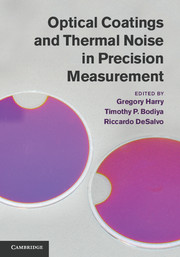Book contents
- Frontmatter
- Contents
- List of contributors
- Foreword
- Preface
- 1 Theory of thermal noise in optical mirrors
- 2 Coating technology
- 3 Compendium of thermal noises in optical mirrors
- 4 Coating thermal noise
- 5 Direct measurements of coating thermal noise
- 6 Methods of improving thermal noise
- 7 Substrate thermal noise
- 8 Cryogenics
- 9 Thermo-optic noise
- 10 Absorption and thermal issues
- 11 Optical scatter
- 12 Reflectivity and thickness optimization
- 13 Beam shaping
- 14 Gravitational wave detection
- 15 High-precision laser stabilization via optical cavities
- 16 Quantum optomechanics
- 17 Cavity quantum electrodynamics
- References
13 - Beam shaping
Published online by Cambridge University Press: 05 January 2012
- Frontmatter
- Contents
- List of contributors
- Foreword
- Preface
- 1 Theory of thermal noise in optical mirrors
- 2 Coating technology
- 3 Compendium of thermal noises in optical mirrors
- 4 Coating thermal noise
- 5 Direct measurements of coating thermal noise
- 6 Methods of improving thermal noise
- 7 Substrate thermal noise
- 8 Cryogenics
- 9 Thermo-optic noise
- 10 Absorption and thermal issues
- 11 Optical scatter
- 12 Reflectivity and thickness optimization
- 13 Beam shaping
- 14 Gravitational wave detection
- 15 High-precision laser stabilization via optical cavities
- 16 Quantum optomechanics
- 17 Cavity quantum electrodynamics
- References
Summary
Introduction
In this chapter we review recent research on using alternative beam shapes for reducing thermal noise and other thermal effects in mirrors. High-precision laser interferometry experiments typically make use of the fundamental Gaussian beam, which can be generated with the great spatial stability that is important for achieving low-noise signal readouts. However, the Gaussian beam might not be the optimal choice for all high-precision measurements. The idea of using an alternative beam geometry, specifically a flat-top intensity profile, to reduce mirror thermal noise in optical cavities was discussed first by Kip Thorne and his research group at Caltech in 2000 (Thorne et al., 2000). Since then several groups have made progress in taking this idea closer to reality. Despite these efforts, no highprecision interferometric measurement actually showing lower thermal noise has so far been undertaken with alternative beam shapes.
Alternative beam shapes improve thermal noise, and specifically coating thermal noise, by effectively increasing the wm parameter of Equation 4.9 and subsequent related equations. Straightforward increasing of the beam width wm of a Gaussian beam will work up to a point, but the optical loss from light spilling over the mirror edge generally will be unacceptable at some level. Thus, with purely Gaussian beams, there is a tradeoff between lower thermal noise (larger wm) and lower shot noise (higher optical power, thus smaller wm). Using beam shapes other than Gaussian is a way to change this tradeoff, because alternative beam shapes can be effectively larger while keeping the light mostly contained on the face of the optic.
- Type
- Chapter
- Information
- Optical Coatings and Thermal Noise in Precision Measurement , pp. 196 - 215Publisher: Cambridge University PressPrint publication year: 2012



